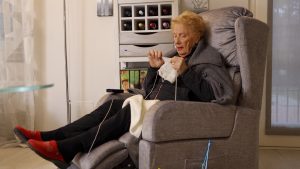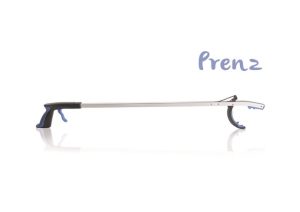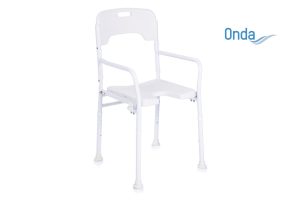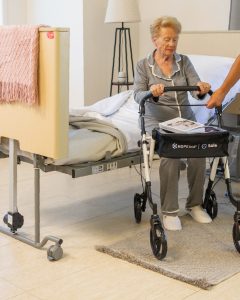Taking care of the people we love also means thinking about the spaces where we live our daily lives. Home, a place of intimacy and memories, can become an environment that protects and supports, capable of accompanying people who are fragile or have mobility difficulties without sacrificing their autonomy and dignity. Rethinking it as a space of care is an act of love that combines attention, prevention and humanity.
Where to start: small steps, big differences
Every project begins with watching. Looking at the house with new eyes, imagining the daily movements of those who live in it, makes it possible to identify critical points and potential hazards. Writing these situations down is the first step in creating a “risk map” and understanding where to begin. There is no need to do everything at once: even a single change can improve quality of life. What matters is proceeding gradually, involving the person concerned.
Living room: comfort that welcomes
 The living room is the heart of the house, the space dedicated to relationships and sharing. Safety begins with organization: removing unstable rugs, choosing furniture with rounded edges, keeping hallways free of obstacles to allow easy movement, even with the help of a walker or rollator. A Mopedia Relax lift chair with a reclining backrest and footrest can become a precious ally: not only does it make sitting down and standing up effortless, but it also provides the right support throughout the day’s activities. To complete the environment, soft lighting and light points along pathways can make the living room welcoming, as well as safe and comfortable.
The living room is the heart of the house, the space dedicated to relationships and sharing. Safety begins with organization: removing unstable rugs, choosing furniture with rounded edges, keeping hallways free of obstacles to allow easy movement, even with the help of a walker or rollator. A Mopedia Relax lift chair with a reclining backrest and footrest can become a precious ally: not only does it make sitting down and standing up effortless, but it also provides the right support throughout the day’s activities. To complete the environment, soft lighting and light points along pathways can make the living room welcoming, as well as safe and comfortable.
Kitchen: practicality in the service of everyday life
 In the kitchen, organization is the key to working safely. Storing dishes and utensils at waist height, for example, reduces the need to bend or stretch too much, preventing unnecessary strain. Reaching aids are a practical help for grabbing objects placed high up or fallen to the floor without resorting to unstable stools or risky movements. Small details matter too: non-slip mats near the sink, single-lever taps that are easy to use, lightweight dishes and chairs with armrests that help maintain stability. A well-organized kitchen is not only safer but also more functional to live in.
In the kitchen, organization is the key to working safely. Storing dishes and utensils at waist height, for example, reduces the need to bend or stretch too much, preventing unnecessary strain. Reaching aids are a practical help for grabbing objects placed high up or fallen to the floor without resorting to unstable stools or risky movements. Small details matter too: non-slip mats near the sink, single-lever taps that are easy to use, lightweight dishes and chairs with armrests that help maintain stability. A well-organized kitchen is not only safer but also more functional to live in.
Bathroom: safety that makes the difference
 The bathroom is often the most delicate space, because many of the risks of slipping and falling are concentrated here. Making it more reliable and comfortable only requires a few targeted measures, such as installing grab bars next to the toilet and shower, non-slip surfaces and solutions that reduce barriers, such as walk-in showers. The choice of aids can also make a big difference: a shower chair or a folding seat provides stability during personal hygiene, while a toilet support with side armrests restores autonomy in daily movements.
The bathroom is often the most delicate space, because many of the risks of slipping and falling are concentrated here. Making it more reliable and comfortable only requires a few targeted measures, such as installing grab bars next to the toilet and shower, non-slip surfaces and solutions that reduce barriers, such as walk-in showers. The choice of aids can also make a big difference: a shower chair or a folding seat provides stability during personal hygiene, while a toilet support with side armrests restores autonomy in daily movements.
Planning the space considering possible future use of aids such as walkers or rollators means preparing the bathroom for all present and future needs.
Bedroom: rest and autonomy
 The bedroom is the place for rest, but also for nighttime safety. An adjustable bed that allows raising the torso or legs can make sleeping and movement easier, while an ergonomic mattress improves comfort. Placing the bed so it can be easy accessible from both sides, pairing it with stable bedside tables and easily reachable lamps, along with sensor lights along the path to the bathroom, makes the environment safer.
The bedroom is the place for rest, but also for nighttime safety. An adjustable bed that allows raising the torso or legs can make sleeping and movement easier, while an ergonomic mattress improves comfort. Placing the bed so it can be easy accessible from both sides, pairing it with stable bedside tables and easily reachable lamps, along with sensor lights along the path to the bathroom, makes the environment safer.
For those at higher risk of falls or in need of support, the bed becomes an element of protection and autonomy. This is the spirit behind the new Mopedia Magnolia line, designed to meet a range of safety and comfort needs. The Magnolia Ultralow model, with a ground clearance of less than 7 cm, reduces risks for those in situations of fragility; the Magnolia 120 and the bariatric version ensure space and stability even for higher weight capacities; finally, the Magnolia Lux model integrates ergonomic adjustments and practical solutions for daily management, both at home and in care facilities.
The choice of wooden structures with a sober and welcoming design also makes it possible to maintain a homely, reassuring environment without giving up advanced functions that promote both personal well-being and the work of caregivers.
A home that embraces life
Reorganizing domestic spaces does not mean overturning the house, but transforming it into an environment that gently supports the gestures of everyday life. It is a journey made up of small steps, of details that become concrete acts of care and that restore safety, autonomy and peace of mind.
A home designed this way is not just a place to live, but becomes a daily embrace: a space that welcomes, protects and gives dignity to those who inhabit it—today and tomorrow.










